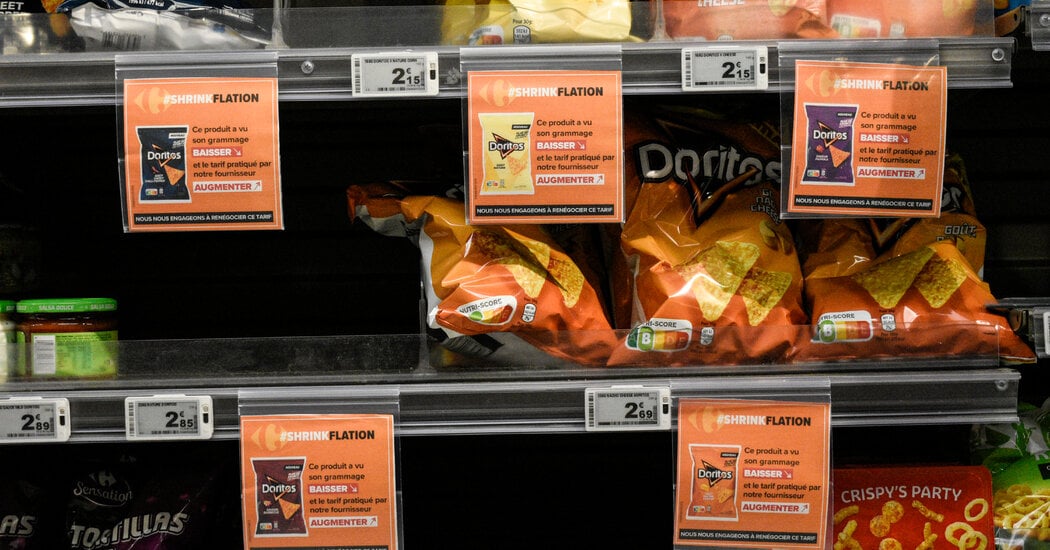- cross-posted to:
- nyt_gift_articles@sopuli.xyz
- cross-posted to:
- nyt_gift_articles@sopuli.xyz
I wish we had a small percent of what France does for its consumer rights in the United States.
That’s because we don’t set shit on fire every time the government looks at us wrong.
Perhaps it’s time to change that
Impossible when 30% of the country is addicted to a 100% propaganda channel
if that 30% were able to do so much damage, the other 70% can do even more.
The other 70% consider political activism posting memes on places like this.
Bringing awareness to issues (even through memes) is a good way to get people who are capable of fighting in on the fight.
What also tends to happen though is that when an issue gets popular, some people jump on the bandwagon for the dopamine hit that comes from the attention they get when they make content about the issue. Hell, even when they don’t make it. I’ve seen stickied comments on clips of popular music videos (just one ridiculous example) posted by fans where they’re saying shit like, “Oh my god guys! Thank you so much for all the likes and comments! I didn’t expect this to be so big!” Ummm, it’s a Beatles clip my guy. You didn’t do anything but reupload a bit of it in short form. You out here acting like you just a member of the band caught off guard by how many people like you.
I always have to be a dick and ask, “Oh, you made this?”
deleted by creator
The real reason the 2A exists and continues as-is: it lets those elites in control rile up the stupid masses (that they keep that way) to literally murder the people trying to fix how fucked up shit has become
deleted by creator
If our representative govt represented us, maybe…but it doesnt, so we wont.
thats why we actually gotta do shit
What’s great about this comment is that every side can say it about the other!
I agree, but it’s also worth noting the influence of police forces, riot police, swat teams, and the national guard.
The US basically has an occupying army to quell unrest in every county across the country, so it’s harder to properly protest without state retaliation. Not to say we shouldn’t do it, but I can understand people’s reticence.
If only they had a right to an armed militia ha ha ha ha ha
Fr. Leftists need to exercise their second amendment rights way more.
Plenty do. There just needs to be more organization.
You’re right. We have idiots setting themselves on fire in front of courthouses instead.
Oh so I’m guessing it did come out he was doing it for Trump? Because the one who did it in protest of the our support of Israel was looked at as a kind of a hero here.
The reporting I’ve seen was that he had been hanging around the courthouse for a few days and was obviously mentally unwell but he essentially thinks Biden and Trump are working together to establish a fascist state and it all heavily involves Peter Thiel. I didn’t read it but someone made a word cloud of his pamphlet and it was all over the place and even involved conspiracy theories of yore that have been supplanted by QAnon and vaccine stuff.
So, I guess bipartisan?
He threw conspiracy theory pamphlets in the air beforehand, so safe bet it was for Trump.
That’s why the French protest all the time. They fight for their rights.

To… Party?
He says rights plural, so it must be parties plural.
Corporations are people and people are allowed privacy, so corporations don’t have to tell you anything, pal!
I think it’s lobbying. The US market is so big it pays off to lobby hard.
THAT’S AMERICA BABY LOVE GETTING STEPPED ON AND ASK FOR MORE OR QUIETLY GET STEPPED ON AND GET MORE ANYWAY HOOOOOAH 🦅🦅🦅🦅🎆🎆🎆🎆
~(Help us)~
This has been the law in Brazil for more than 10 years now. We have lots of problems here, but at least our consumer protection laws are top notch. And, believe or not, they’re enforced successfully.
Thanks for sharing, it’s great tk hear and I didn’t know!
For real? I live in brazil and never noticed any warnings on price increases, or size changes…
I was wrong in one thing, it hasn’t been a thing for 10 years, but for 20. It was determined by the Minister of Justice, based on article 55 of the Consumer Protection Code. More here. I remember seeing some warnings on labels back when the rule was new. My opinion is that companies got smarter and realized that those warnings were damaging to their brands, so they just stopped with the practice of shrinking products, which is why you never noticed.
Será que é por isso que sempre tem aqueles avisos de “nova embalagem”? Ou talvez fique escrito nas letrinhas pequenas atrás? Nunca percebi algo assim, mas muito legal saber que essa lei existe!
edit: se pesquisar por “reduflação” no google imagens, aparecem vários exemplos disso. Estou impressionado que eu nunca via algo assim…
Really we just need to standardize sizes for consumer goods. For example: drinks can come in 250, 500, 750, 1000, and 2000 mL sizes. Sold soap must be sold in units of 100, 500, or 1000 grams. And so on…
But then you get shrinkflation in the product itself. Less emulsifiers in the soap, drinks with corn syrup replacing sugar, and powders like cinnamon cut with lead powder.
Not saying it couldn’t be done, just that businesses are really incentivised to find the loopholes and exploit them.
In Australia we call this “skimpflation” because they aren’t shrinking the final product, they’re skimping on ingredients to lower production costs.
It’s the bane of my existence because brands I know and love will change their ingredients without warning and without changing anything on the packaging (sometimes not even changing the ingredients list! If the ingredients list has always just said “starch” they don’t have to change anything going from arrowroot starch to cheaper potato starch)
I have allergies and I’ve bought two boxes of the same product at the same time, and had an allergic reaction to one, but not the other.
I used to always blame it on my housemates not washing the cooking utensils properly, but I now use separate cooking equipment and I clean down the kitchen before I start and cook at odd times so I’m the only one using the kitchen.
I’ve started emailing companies after my allergic reactions to determine if they have changed an ingredient, and 90% of the time they confirm they have changed the ingredients. Usually they put some PR spin on it about the new ingredient being more allergy friendly or sustainable (they don’t clarify “environmentally” so I assume they mean “financially sustainable for the profits of our company”)
Here they label this as “New Recipe!”. As if they’re somehow doing us a favour.
Oh gee I wonder what inspired you to change the recipe 🤔
Less emulsifiers in the soap, drinks with corn syrup replacing sugar, and powders like cinnamon cut with lead powder.
Standard formulas for a given product. Anything that isn’t 40% sugar drink is “immitation soda drink”. Anything that’s under-emulsified can’t be called real soap.
These are solvable problems at a regulatory level. But at some point, it may be more cost efficient to simply nationalize the under-performing industry. Perhaps Coca-Cola just can’t cut it making soda drinks anymore, and the firm needs to be broken up and devolved to the various states as State Soda Bottling Company
They already do that. So no downsides for this proposal. There was some article some years ago about how the taste of things like cookies changed because they went for cheaper recipe.
I don’t think this is the ideal situation. The way food prices are advertised needs to be standardized: € / kg or $ / freedom unit. + size + unit price. I think it’s already the law in EU, but supermarkets try to hide the per kg price in a tiny almost unreadable printsize.
We used to have standardized package sizes in the EU for things like butter, chocolate, etc. So stupid to give that up
I guarantee it’s because of neoliberals and conservatives trying to emulate The US.
It was in the name of customer convenience and individualism of course. Think of the singles!
But luckily, we now have guidelines on how crooked a banana has to be to not be thrown into the trash!
That is what a respectable government looks like
It feels a bit “least we could do” ish?
They’re not setting standard size scales for basic products or establishing price floors based on wholesale/production costs, much less intervening to increase supply or reduce overhead costs.
This is a bit like the surgeon generals warning on a pack of cigarettes. Nice, I guess. But hardly a game changer.
Meanwhile in America
Haha big business go brrrrrr
I feel it’s a good first step.
It’s a third or fifth step. They already have laws against wastage, throwing out food, etc.
Here’s my attempt at copying the article for readers:
To Fight ‘Shrinkflation,’ France Will Force Retailers to Warn Shoppers
- Merchants will be required to put signs in front of all products that have been reduced in size without a corresponding price cut.
For months, the shelves of Carrefour, France’s biggest supermarket chain, have been dotted with bright orange signs placed in front of Pepsi bottles, Lays potato chips and a variety of other foods whose packages are suspiciously smaller than they used to be.
“Shrinkflation,” the signs say. “This product has seen its volume decrease and the price charged by our supplier increase.”
On Friday, the French government took steps to require every food retailer in the country to follow suit. By July 1, stores will have to plaster warnings in front of all products that have been reduced in size without a corresponding price cut, in a bid to combat the consumer scourge known as shrinkflation.
“The practice of shrinkflation is a scam,” Bruno Le Maire, France’s finance minister, said in a statement. “We are putting an end to it.”
The government is also encouraging shoppers to act as informers, urging those “who have doubts about the price per unit of measurement displayed on the shelves” to flag it to the authorities via France’s consumer reporting app.
The fight against the practice of downsizing products without also downsizing their prices has picked up in the United States, where President Biden has shamed food companies for raising prices even as inflation cooled.
Shrinkflation has become a point of outrage for shoppers in France, and a political issue for President Emmanuel Macron as consumers continue to grapple with a cost-of-living crisis. Although inflation has recently come down in Europe from the record highs of a year ago, the prices of many food products remain elevated.
Inflation in the eurozone fell to a new two-year low in March, the result of an aggressive campaign of interest rate increases by the European Central Bank. European governments had also worked to ease prices for energy and food, through subsidies for electric bills and by negotiating with food manufacturers to force prices down.
In France, inflation has fallen now more than a third from a year earlier, but higher food prices have been persistent. A typical basket of food basics that includes items such as pasta and yogurt is 3 to 5 percent higher than it was a year ago, after a 16 percent surge for 2023.
Mr. Macron had promised to wrestle food costs down further this year. The government moved up annual price negotiations between suppliers and retailers in February, and put pressure on companies to limit increases.
The shrinkflation campaign is the latest weapon. Stores will have to display signs for two months after downsized products have been put on their shelves, according to the government decree issued Friday. The signs will appear near a variety of goods made by food companies, as well as for the supermarket’s private-label brands, from snacks and soda to bags of rice and laundry detergent. Prepackaged foods, like shrink-wrapped deli cold cuts or foods sold in bulk, will be exempt.
Many global consumer goods companies have raised prices by double-digit percentages in the past year, attributing the increases to higher costs of ingredients and labor. Even so, many of those companies have reported expanding profits as they sell fewer items at higher prices.
The issue came to a head in France last year when Carrefour announced that it would no longer sell PepsiCo products because the prices were “unacceptably” high for consumers, escalating a showdown by French retailers to name and shame brands that were not reducing prices as inflation eases.
As part of its campaign, Carrefour also put up shrinkflation posters next to products like Lipton tea warning shoppers that they were paying a higher price for a product whose volume had shrunk.
France has submitted a proposal to the European Union that would force food retailers throughout Europe to carry out a shrinkflation labeling campaign.
-Merchants will be required to put signs in front of all products that have been reduced in size without a corresponding price cut.
What’s to stop the manufacturer reducing the item by, for example, 10% in size, and 2% in price?
I’d hope that’s covered by the definition of corresponding, though I am neither French nor a legal expert so I can’t say for sure.
I would think that would be covered by the corresponding price cut part. If they are smart they put in a clause that says the price cut has to be proportional or bigger otherwise it is considered shrinkflation.
I think the unit price should be more prominent than the price per item.
And the units should be consistent. It drives me nuts when I’m in a store and the unit varies across different sizes of the same product.
Who the fuck even knows what the unit price of paper towels is?!
Turns per roll on one brand, grams per inch for the next, and ounces per half-roll for your third choice.
And each brand has a different tear-off square size. Some have ‘jumbo size’ and also ‘pick-a-size’ where its smaller rectangles tear offs instead of squares.
How do you compare? You dont and its by design
Weight…
At this point I just stopped buying chips. Feels like such a waste to fill the bag less than half way…
good for you. Not really a necessity anyhow, have some nuts, it’s better for you.
Nuts are crazy expensive though unfortunately
Have some roasted edamame, unfortunately they taste a bit shit though.
I have some toasted chick peas, they taste great, but they dry my mouth out so fast.
Greed is now baked into capitalism. Morals and ethics be damned, squeeze and squeeze and see what the market and consumer will bear. So what if much of the population is struggling economically, and more have been thrown into outright poverty. And that record number of people are homeless and sleeping rough.
Consolidation and deregulation always benefits the few over the many, all the while claiming it will be beneficial to consumers. I’m always amused by the religious folks who defend free market greed as though God is a cruel, exploitive being who’s big on dog-eat-dog capitalism.
Margin expansion under the guise/cover of inflation should be criminal.
What I would love to see one day is the margin pocketed for every product sold on display next to the price tag.
Retailers could have chosen to eat these higher costs and weather lower profit margins, but instead, the FTC found that on aggregate retailers passed all higher costs onto consumers and raised prices even more to increase their profit margins, too. This finding isn’t totally new, several economists and researchers (including me) pointed out this trend at the time. https://www.foodandpower.net/latest/ftc-supply-chain-disruption-grocery-food-processing-report-apr-24
as though God is a cruel, exploitive being who’s big on dog-eat-dog
The Christian god definitely is. I don’t know where Christians got the idea of a loving god but it wasn’t from their bible.
I was thinking about this the other day when I noticed my deodorant was 2.7fl oz instead of the usual 3. The stores are complicit. They know every time something shrinks because they have to print new tags. Even if it’s the old price, the unit price has changed, and I believe the barcode is different.
No warnings. No heads up. Just silent acceptance. Sure, if they posted a warning I wouldn’t buy that product but dammit I need deodorant!
Look up the lyrics to “If I Had A Rocket Launcher” for instructions on how to deal with this kind of theft.
I’ve never heard this song before but I fucking love it.
Is this guys other stuff like this or can you recommend other similar themed songs?
So, they cut the price and cut the size followed by a price raise 6 months later?
They cut the size, but not the price. Then they increase the price six months later.
Even the title says “signs in front of all products that have been reduced in size without a corresponding price cut”
or cut the size but keep the price the same, then release a new “jumbo size” that’s as big as the previous size (with the new and improved higher unit price), then discontinue the “standard” size.
This seems like a great idea and i wouldn’t mind it getting expanded to become an EU wide norm.
That said it only adresses part of the problem. Another way consumers get tricked are recipe changes to substitute expensive ingredients for cheaper ones. And this one also subverts the mandatory kg/€ (or litre/€) price notices, which in a way already help with identifying shrinkflation. Although prominent warnings would help a lot fighting the psychological tricks involved in shrinkflation.
Personally i would also like laws to go even further and make it mandatory for companies to maintain public databases with product sizing and ingredients. Although i assume it wouldn’t be easy to fight against companies trying to subvert such system and claiming that near identical products are something new rather than just a new worse version of something existing.
On that note i also miss the more standardized portion sizes we had here in Germany for a lot of products. Actually something that sadly had to be abolished due to eu regulations, which at the same time at least seemed to have given us the already mentioned kg/€ price labels.
I had to jog my memory with this article (in german) from 2009 when the change apparently happened. An example it gives is that e.g. sugar (up to a size of 1kg) could only be sold in portions of 100, 250, 500, 750 und 1000g. So no trickery with random inbetween sizes. Obviously not a huge problem with something like sugar, but it similarly also applied to something like chocolate bars. Which nowadays come in the most random, constantly changing weights.
Maybe a bit heavy handed, but i wouldn’t mind fighting shrinkflation in some areas by simply forcing standardized sizes.
I don’t think this is the right way to go. Mandatory “compare prices” to be displayed with the same, or better, viability as the price is much better. That way the consumer immediately sees that the price went up since last week. What it also brings is the opportunity to compare which one of two sizes of the same product is a better deal.
I’m sorry but I don’t understand your suggestion. That’s what the sign does. It warns clients when the package got smaller and or price went up. Also, all stores are obligated to show the price/kg on all products so it’s easy to compare.
You don’t need a special sign for shrinkflation. What’s needed is just price per kg (I live in the metric world) displayed as big as the price per unit. This should be enforced as the norm and not on whether the store wants to do it or not.
Consumers who aren’t interested enough to keep track of price increases since last week won’t care about a special sign either.
Price per kilogram is good if you want to compare product A vs product B (we already have that). Here the point of this law is to be able to compare product A with itself in another point in time, because there is nothing actually in place to be able to reliably do that other than keeping a list of all prices at all time. The two together will be a very good tool to inform the consumers about the shady practice of some producers…
The whole point with shrinkflation is to trick the consumer to think that they’re buying the same amount when they don’t.
If you make it easy for the consumer to see what the cost is per kilogram, they will immediately see that the price for the same size package of cereal they always buy has gone up.
It’s okay if you want to pay extra for your groceries, but I don’t. I’m perfectly fine with compare prices since the compare prices are unaffected by the change of package sizes.
No, because some things I only buy once a month or less… I’m trying my best to remember all the prices and all, but it’s easy to miss these kinds of things when there’s dozens of things you’re buying. So yes, an extra warning for when a product got more expensive is fine. Again…the price/kg is already there, not sure why you’re beating that poor horse. This is on top of the price/kg. An extra warning, not replacing the price/kg sign, which, again, is already below every item in the store.
Good luck with someone doing your work for you.
Producers make millions on shrinkflation. That means they have millions to spend on finding a way around this and you as a consumer will still end up paying for it. I hope I’m wrong, I really do but I’m sure they will find a way around this.
“If it’s not a 100% perfect all encompassing solution then it’s not worth doing” is such a braindead take of which I see people like you make everywhere
I love the friendly tone you have in a discussion.
It’s not the producers that’s going to pay for putting up and taking down the signs. It’s the stores and in the end the consumers.
Add to this the cost of having someone going around checking that the rules are followed.
Keeping track of whether there is a compare price or not on all items is much easier and cheaper.
So yeah, it’s a populist solution putting up signs for price increase only for goods that has shrunk and it seems extremely easy to circumvent if you want to.
Here’s how you circumvent it: Introduce a 750g, 900g and 1000g package of the product. 900g is more expensive per gram than the 1000g. Then you have a “shortage” on the 1000g package and some stores run out of it. There’s no shrinkflation here since the 900g package has been there all the time.
There’s a lot of money to make here so hiring a lawyer that finds every single loophole will be a good investment.
But yeah, you call the take braindead and watch the politicians, lawyers and producers laugh over a change that cost you, not them, money.
The best filters are made of many layers of different size holes
I do that because I used to work in grocery stores and can noticed even small, incremental price changes on many items. Most consumers don’t do that and hardly notice 3 cents more on this and 2 ounces short on that. We are already accustomed to toilet paper and laundry detergent mega-size and “concentrated” bullshit.
If you buy the same package size cereal every week you will notice if the price went up. Compare prices neutralizes shrinkflation.
My guess ( <- guess!) is that most people who don’t care about compare prices won’t care much about the signs.
In the US grocery stores are required to list the cost per weight. It mostly works, unless one of the manufacturers decides to show the price in grams or kilograms, as opposed to oz or pounds.
That needs to be regulated then. It doesn’t really matter if the unit you buy is measured in pounds and the compare price is in kilograms per dollar, you’ll still see the change in price of the compare price unit is standardized.
Amazon fresh always gets those prices completely wrong.
Thats also displayed in almost every store.
Where I live (Sweden) it’s not mandatory by law and it just happens to be that most often compare prices are printed in a much smaller text size as compared to the price.
Crazy, huh?
It really needs to be weight/price or size/price then. The way this sounds in the article the producers just also need to change price a little to avoid getting that sign. Per weight or size that might still end up more expensive for the consumer.
That was what I meant with compare price. Sorry for being unclear. Compare price should be weight per price. That way you would see the price increase since the product (that looks the same but isn’t because of less amount in the package) suddenly got a higher compare price since last week while the purchase price is the same.
Price per kg is still mandatory in France. The full history of it for every product is not. So we don’t necessarily notice the price increase if it’s done in small increments
New fun size!
SAME GREAT TASTE!!!






















